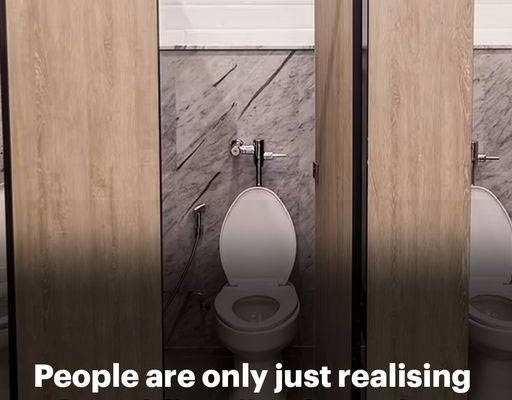Have you ever wondered why public toilet doors don’t reach the floor? While the design might seem odd at first, there are many practical reasons for this choice. From improving safety to cutting costs, this feature addresses key challenges in public restroom management. Let’s dive into the logic behind it.

1. Emergency Access
One of the primary reasons for the gap is to ensure quick access in emergencies. If someone inside the stall requires assistance, the opening allows others to assess the situation and provide help.
“If there’s ever an emergency, it would be pretty easy to see what happened and get the person some help,” explains TikTok user MattypStories.
2. Easier Cleaning
Keeping public bathrooms clean is no small task, and the gap makes it much easier for custodians. Mops, pressure washers, and other cleaning tools can easily reach under the doors, ensuring a more thorough cleaning process.
According to a toilet fitting company, ToiletPartitions, “The open floor plan makes it easy for janitors to clean the stalls. A mop or pressure washer can easily fit into the stalls and between the doors.”
3. Cost-Effective Design
Public restrooms are designed with budget considerations in mind. Doors that stop short of the floor are less expensive to manufacture and install than full-length alternatives, reducing overall construction and maintenance costs.
“It’s a lot cheaper to buy a door that has part of it cut off than the full door itself,” says MattypStories.
4. Improved Air Circulation
Good ventilation is essential in public restrooms, and the gaps at the bottom of the doors help facilitate better airflow. This helps unpleasant odors dissipate more quickly, improving the overall environment.
As WC Portables explains, “The gap between the door and the floor provides a quick escape of the foul smell that was generated by previous users.”
5. Deters Misbehavior
Public bathrooms sometimes attract inappropriate behavior. The reduced privacy of shorter doors discourages misconduct, making it easier for others to spot and prevent such actions.
“Shorter doors help ensure the toilet queue flows and people refrain from exhibiting poor behavior due to the embarrassment of being spotted,” notes WC Portables.
6. Quick Exit in Case of Emergencies
What happens if a door lock jams? The gap allows individuals to crawl out if they’re trapped inside. It’s a simple yet effective solution for avoiding potentially stressful situations.
“If the door gets stuck, you can crawl out,” one user suggested.
7. Easy Occupancy Check
No one likes awkwardly knocking on a stall door to see if it’s occupied. The gap provides a quick visual cue, saving time and embarrassment.
“ToiletPartitions explains, “Rather than having to knock on the door to see if a public bathroom is available, a gap at the end of the stall helps to determine if the stall is vacant or not.”
8. Faster Turnover
The reduced privacy of raised doors often leads to shorter bathroom visits. People tend to wrap up quickly when they feel exposed, leading to faster turnover and shorter wait times for others.
“When individuals sense others can listen to their business that easily, they are prone to wrap up quickly,” says WC Portables.
9. Convenient Access to Supplies
Running out of toilet paper in a public stall is a nightmare, but the gap allows for easier assistance. Whether it’s passing toilet paper or getting help, the opening makes communication with others outside the stall much easier.
“You can ask someone for toilet paper if you don’t have it,” another user noted.
Conclusion
While the design of public toilet doors might seem unconventional, it serves multiple practical purposes. From ensuring safety and promoting hygiene to reducing costs and improving efficiency, these gaps are a thoughtful part of restroom design. So, next time you find yourself in a public restroom, you can appreciate the logic behind this unique feature.



